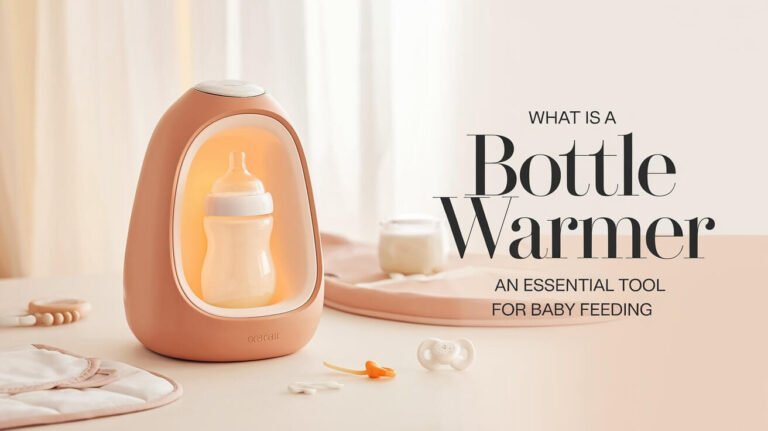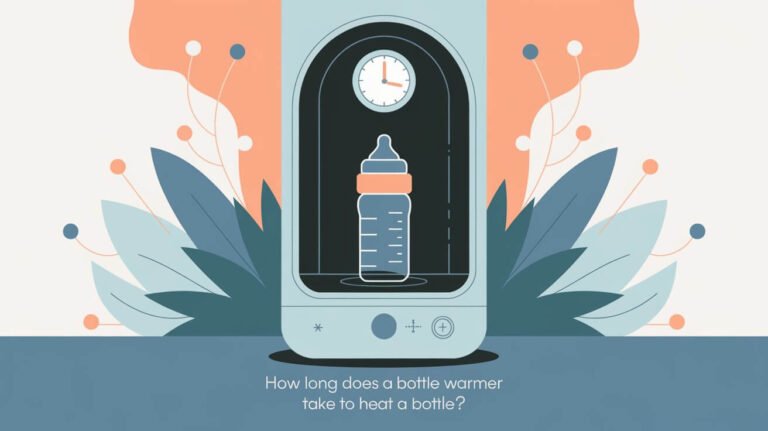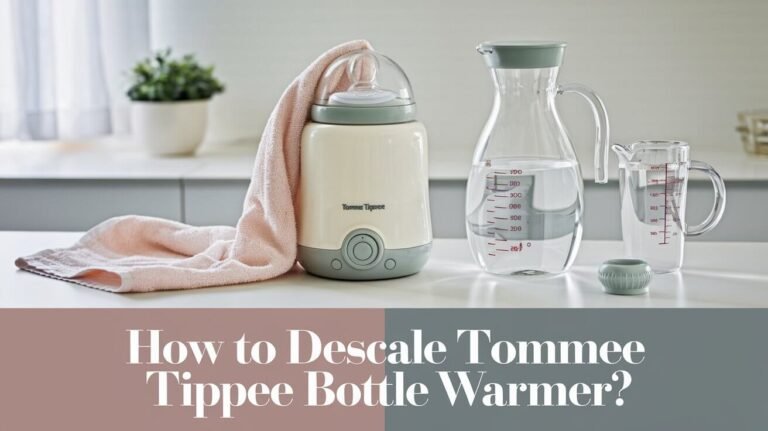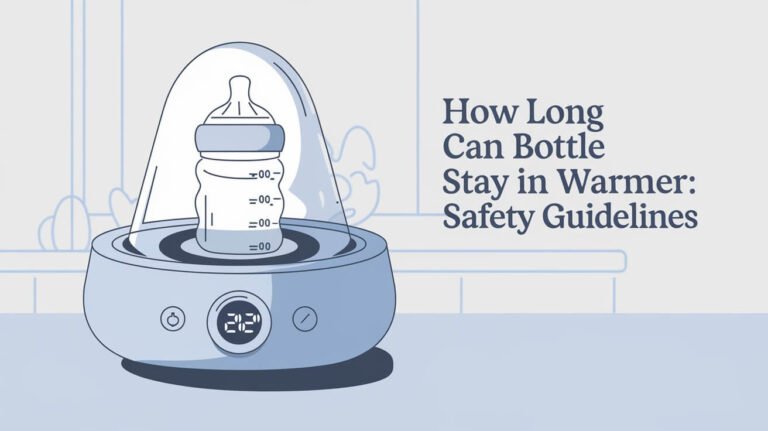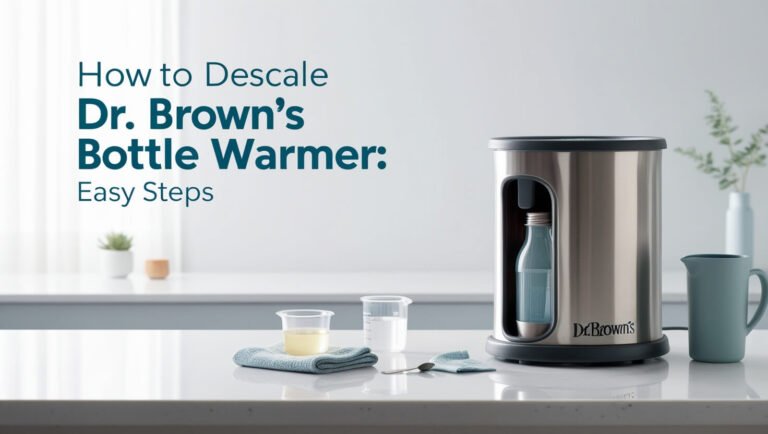How to Descale Philips Avent Bottle Warmer Guide
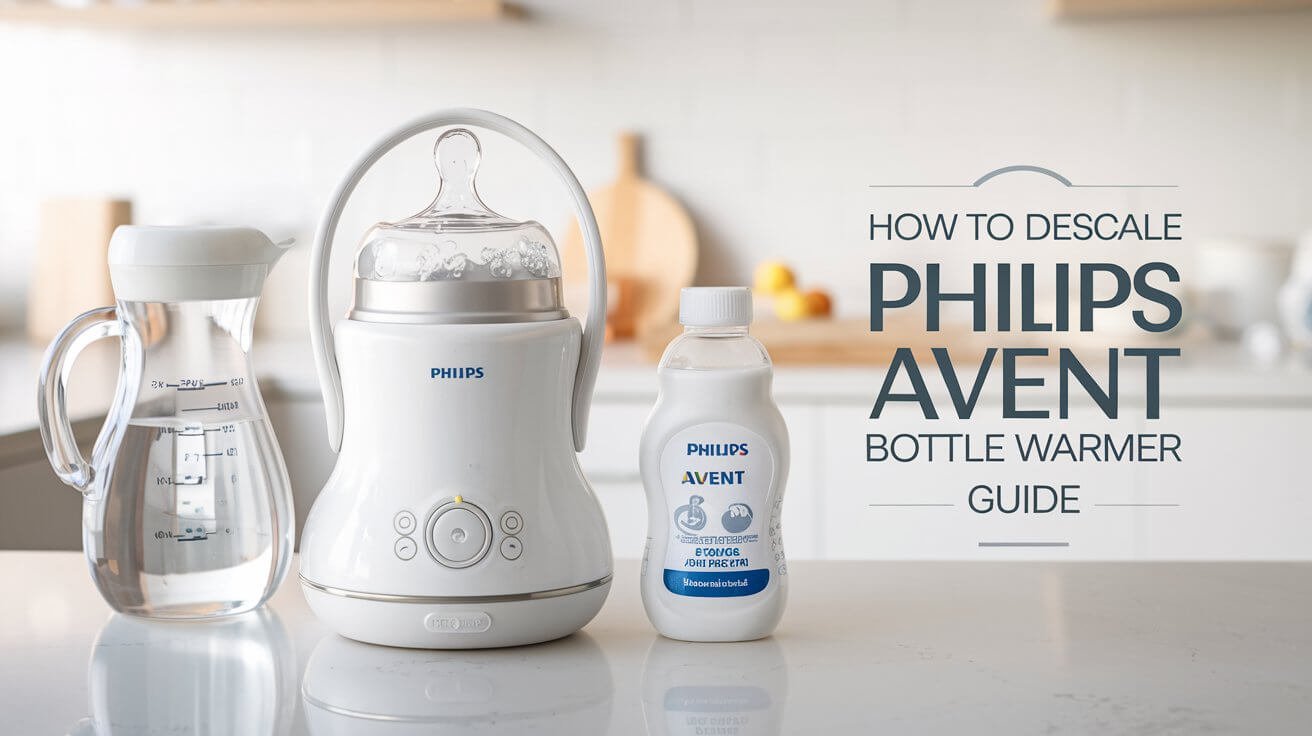
As a dedicated parent, you’ve likely bought the Philips Avent Baby Bottle Warmer. It’s designed to keep your baby’s meals at the perfect temperature. But, did you know descaling it regularly is key to its best performance?
Learn how to keep your bottle warmer in great shape. Find out the essential steps to keep it efficient and clean for your baby’s meals for years.
Why Regular Descaling Makes a Difference
Keeping your Philips Avent bottle warmer in great shape is key for its best performance and life span. Tap water can leave mineral deposits in the device over time. This can make it less efficient at heating and less reliable. Regular descaling helps keep your warmer working well and stops mineral buildup.
Effects of Mineral Buildup on Performance
Mineral deposits in the warmer’s heating chamber can cause longer heating times and uneven temperatures. This can be a problem when you need to warm a bottle fast for a hungry baby. The buildup can also shorten the appliance’s life, possibly leading to expensive repairs or needing a new one.
Signs Your Bottle Warmer Needs Descaling
There are clear signs it’s time to descale your Philips Avent bottle warmer. If you see longer heating times, mineral deposits, or a drop in performance, it’s time to remove mineral buildup and clean philips appliances.
| Bottle Warmer Model | Heating Time for 5 oz Bottle | Temperature Reach | Additional Features |
|---|---|---|---|
| Philips Avent | 3 minutes | 98.6°F (body temperature) | – |
| Munchkin | – | – | Built-in timer, adjustable temperature, auto shut-off |
| The First Years | – | – | Accommodates wide-neck bottles and baby food jars |
Required Materials for Descaling Process
To descale your Philips Avent bottle warmer, you’ll need a few things. White vinegar is key as it’s a natural and effective cleaner. You’ll also need a measuring cup to mix the vinegar with cold water.
Some Philips Avent bottle warmers can also use citric acid-based descalers. These can give a deeper clean and remove tough mineral buildup.
It’s important to have all the materials ready before you start. This makes the descaling process easier and more efficient for your Philips Avent bottle warmer.
- White vinegar
- Cold water
- Measuring cup
- (Optional) Citric acid-based descaler
With these basic items, you can descale your Philips Avent bottle warmer well. This keeps it working great for your baby’s meals.
How to Descale Philips Avent Bottle Warmer
Keeping your Philips Avent bottle warmer clean and efficient is key. Regular descaling stops mineral buildup and keeps it working well. Here’s how to descale your Philips Avent bottle warmer step by step.
Preparing the Descaling Solution
To make the descaling solution, mix 60ml (2 ounces) of white vinegar with 120ml (4 ounces) of cold water. This mix will clear out mineral deposits in your philips avent instructions bottle warmer.
Step-by-Step Cleaning Process
- Pour the prepared descaling solution into the bottle warmer’s water reservoir.
- Select the express milk warming setting and let the solution run through for 10 minutes.
- After, rinse the bottle warmer well with tap water to get rid of any vinegar left.
Post-Descaling Care
After descaling, make sure to take care of your descaling baby products bottle warmer. Clean the outside with a damp cloth to wipe away spills. Let it dry completely before you use it again.
By following this easy philips avent instructions guide, you can descale your Philips Avent bottle warmer. This keeps it working great for your baby’s meals.
White Vinegar Method for Deep Cleaning
Keeping your Philips Avent bottle warmer clean is key for its best performance and life span. Regular wiping and occasional descaling are important. But, a deep clean with white vinegar can make a big difference.
The white vinegar method is great for getting rid of tough mineral buildup. It brings your bottle warmer back to its best state. For the Philips Avent SCF922 model, mix 60ml of water with 30ml of white vinegar. The vinegar should have 6-8% acetic acid.
- Mix the vinegar solution in the bottle warmer’s chamber and let it sit for about 20 minutes, but no more than 1 hour.
- Drain the solution and rinse the chamber well with clean water to get rid of any leftover vinegar.
- Wipe the interior with a damp cloth to make sure it’s clean.
- Let the bottle warmer air dry completely before putting it back together and using it again.
This vinegar cleaning method is very good at deep cleaning warmers. It gets rid of stubborn mineral deposits that can slow down the device. By doing this deep cleaning, you can keep your Philips Avent bottle warmer working its best and last longer.
Safe Descaling Solutions and Alternatives
Keeping your Philips Avent bottle warmer in great shape means regular descaling. White vinegar is a common choice, but safer, better options exist. Citric acid-based descalers are a great alternative.
Citric Acid-Based Descalers
Citric acid solutions are perfect for descaling your bottle warmer. They’re gentle and natural, removing mineral buildup without harming your appliance. Plus, they’re safe for baby bottle accessories, keeping your baby’s feeding gear clean.
Solutions to Avoid
Not all descalers are safe for your bottle warmer. Stay away from products with strong acids, abrasives, or harsh chemicals. These can damage your appliance and reduce its performance.
These easy steps after cleaning keep your Philips Avent bottle warmer in good condition. Choosing the right product keeps your appliance working well and lasts longer.
Model-Specific Descaling Instructions
Descaling your Philips Avent bottle warmer needs specific steps for each model. The general process is similar, but each model has its own set of instructions.
The Philips Avent SCF358/00 model suggests using the milk warming setting for small amounts. Always check your user manual for the right steps for your model.
The manual warns about the dangers of not descaling. It says not to try to fix it yourself. If you need help, contact Philips Consumer Care Center.
The manual also talks about safety. It gives tips on handling hot water and surfaces. It also tells you when it’s safe for kids to use it. Plus, it says the appliance meets safety standards for electromagnetic fields.
| Model | Descaling Instructions | Additional Notes |
|---|---|---|
| Philips Avent SCF358/00 | Use the milk warming setting for contents under 180ml/6oz | Refer to user manual for detailed guidance |
| Philips Avent SCF355 | Descale instructions provided on page 15 of English manual | Manuals available in multiple languages |
| Philips Avent EP1220/00 | Follow the general descaling process outlined in the user manual | Ensure to install a new AquaClean water filter after descaling |
Check your user manual for the correct descaling steps. This keeps your Philips Avent bottle warmer working well and lasting longer.
Time Requirements for Effective Descaling
Keeping your Philips Avent bottle warmer in top shape means regular descaling. The time needed for this task depends on how much mineral buildup there is. A 10-minute cycle is usually enough for a standard clean. But, if the buildup is worse, you might need to soak it for 20 minutes to an hour.
Duration Based on Buildup Level
Notice your warmer’s efficiency dropping or it takes longer to heat up? It’s time to descale. Waiting too long between cleanings means more buildup. This makes the cleaning process longer.
Optimal Soaking Periods
- For light to moderate scale buildup, a 20-minute soaking period is typically sufficient.
- For moderate to heavy scale buildup, soak the warmer for 30 minutes to an hour to ensure thorough cleaning.
- For heavily scaled or neglected warmers, an extended soaking period of up to an hour may be necessary to effectively remove the accumulated deposits.
Always follow the maker’s guide and use the right descaling solutions. This keeps your Philips Avent bottle warmer working well and lasting longer. Regular bottle warmer maintenance and descaling baby products keep things running smoothly.
Maintenance Schedule for Your Bottle Warmer
Keeping your Philips Avent bottle warmer in good shape is key. Regular descaling and cleaning help it last longer. This also keeps your philips avent bottle warmer and baby bottle accessories working well.
It’s smart to set a descaling schedule. This depends on how often you use it and your water’s hardness. If your water is hard, you’ll need to descale more often.
- For light to moderate usage (1-2 bottles per day), descale your philips avent bottle warmer every 2-3 months.
- For heavy usage (3 or more bottles per day), descale the device every 4-6 weeks.
- If you notice a decline in the warmer’s performance or an increase in mineral buildup, it’s time to descale, regardless of the schedule.
These easy steps after cleaning keep your Philips Avent bottle warmer working well. It’s a reliable way to warm your baby bottle accessories.
| Usage Frequency | Descaling Schedule |
|---|---|
| Light to Moderate (1-2 bottles per day) | Every 2-3 months |
| Heavy (3 or more bottles per day) | Every 4-6 weeks |
By sticking to this maintenance plan, your philips avent bottle warmer will keep warming your baby bottle accessories efficiently for years.
Troubleshooting Common Descaling Issues
Descaling your Philips Avent bottle warmer is key to keeping it working well. You might run into some problems while descaling. But don’t worry, we have tips to fix these issues and get your bottle warmer working great again.
If scale traces stay after you first descale, don’t worry. You might need to descale again. Try using more vinegar or soaking it longer to get rid of tough buildup. Always rinse it well after descaling to get rid of any leftover solution.
For really tough buildup, you might need a different descaling solution. Citric acid-based descalers can be good for deep cleaning. Just make sure to follow the instructions and avoid harmful solutions.
| Common Descaling Issues | Troubleshooting Solutions |
|---|---|
| Persistent scale traces after initial descaling | Repeat the descaling process Increase vinegar concentration slightly Extend the soaking time Ensure thorough rinsing after each attempt |
| Stubborn mineral buildup | Use a citric acid-based descaler Follow manufacturer’s instructions carefully Avoid solutions that could damage the appliance |
Regular descaling is vital for your Philips Avent bottle warmer’s best performance. By tackling common problems quickly and following the right steps, you keep your baby’s products safe from mineral buildup.
Safety Precautions During Descaling
Keeping your Philips Avent bottle warmer in top shape is key. Descaling is a critical part of this. It’s important to stay safe while doing it. Here are the main steps to follow for a safe cleaning.
Electrical Safety Measures
First, unplug the bottle warmer before you start. This prevents electrical shocks or short circuits. Also, keep your hands dry and don’t soak the whole appliance in water. This could harm the inside parts.
Proper Ventilation Requirements
When using vinegar for cleaning, make sure the area is well-ventilated. Vinegar fumes can be bothersome if the air isn’t fresh. Open windows or use fans to keep the air moving.
Also, be careful with the cleaning solutions. They can hurt your skin. Wear gloves and avoid touching the chemicals. If you do get some on your skin, wash it off with water right away.
By taking these precautions, you can clean your Philips appliances safely. This includes your bottle warmer. It keeps you safe and makes your appliance last longer.
Storage and Post-Cleaning Care
After descaling your Philips Avent bottle warmer, it’s important to store and maintain it right. Start by wiping the outside with a soft, clean cloth. This removes any leftover residue or moisture.
For storage, pick a clean, dry spot away from sunlight or moisture. This keeps the bottle warmer in top shape for the next time. Remember, cleaning and storing well helps your Philips Avent bottle warmer last longer.
Taking these simple steps after cleaning keeps your Philips Avent bottle warmer working properly. It’s a reliable way to warm your baby’s bottles for years. With a well-kept appliance, you can easily and confidently feed your baby.
Frequently Raised Questions
What is the recommended solution for descaling a Philips Avent bottle warmer?
Use a mix of white vinegar and water to descale a Philips Avent bottle warmer. This combo removes mineral buildup. It also makes the appliance last longer and work better.
How does mineral buildup affect the bottle warmer’s performance?
Mineral buildup can slow down the bottle warmer. It makes heating take longer and leaves deposits. Regular cleaning keeps it working well.
What materials are needed for the descaling process?
You’ll need white vinegar, cold water, and a measuring cup. Some bottle warmers can also use citric acid-based cleaners instead of vinegar.
How do I prepare the descaling solution?
Mix 60ml/2oz of white vinegar with 120ml/4oz of cold water. Then, pour it into the bottle warmer for cleaning.
What is the step-by-step process for descaling the Philips Avent bottle warmer?
Here’s how to descale it: 1. Pour the vinegar-water mix into the warmer. 2. Choose the express milk warming setting and run it for 10 minutes. 3. Rinse it well with tap water after descaling.
Can I use other types of descalers beside white vinegar?
Yes, you can use citric acid-based cleaners as a safe alternative. But, avoid other descalers to prevent damage. Stick to what the maker suggests for best results.
Are there any model-specific instructions for descaling the Philips Avent bottle warmer?
Yes, different models have their own descaling steps. For example, the SCF358/00 model uses the milk warming setting for contents under 180ml/6oz. Always check your user manual for specific guidance.
How long should the descaling process take?
The time needed for descaling varies with buildup levels. For basic cleaning, 10 minutes is usually enough. For tougher buildup, soak it for 20 minutes to 1 hour, depending on the model and buildup.
How often should I descale my Philips Avent bottle warmer?
Descale frequency depends on usage and water hardness. Regular maintenance keeps it running well and lasts longer.
What safety precautions should I take during the descaling process?
Unplug the warmer and ensure good ventilation when using vinegar. Avoid skin contact with the solution. Rinse well if you do get some on your skin.
How should I store and care for the Philips Avent bottle warmer after descaling?
Store it in a clean, dry place after descaling. Wipe the outside with a soft cloth to keep it looking good. Regular cleaning and proper storage prepare it for next use.

